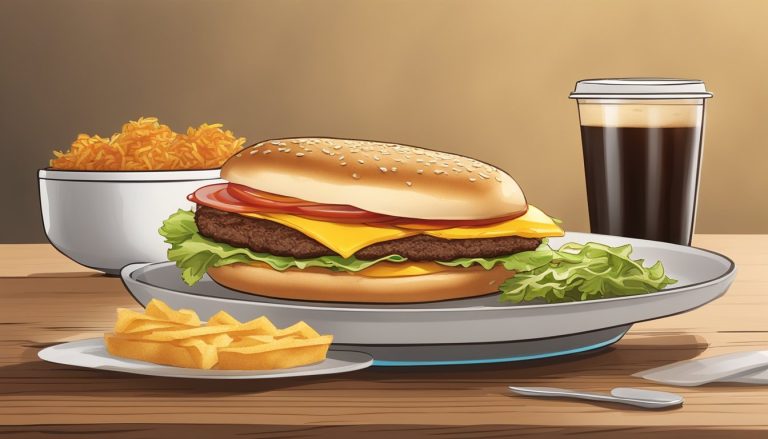Jimmy Dean breakfast sandwiches offer a convenient and tasty morning meal option. These frozen sandwiches come in various flavors, typically featuring eggs, cheese, and meat on an English muffin, biscuit, or croissant. To cook a Jimmy Dean breakfast sandwich, thaw it completely, then wrap in foil and bake at 350°F for 20-25 minutes until hot.
For those seeking a protein-packed start to their day, Jimmy Dean sandwiches deliver. The combination of eggs, cheese, and sausage or other meats provides a satisfying boost of energy. Some varieties even incorporate honey for a touch of sweetness.
Proper preparation ensures the best flavor and texture. While microwaving is quicker, oven baking yields superior results. By separating the sandwich components and wrapping them individually in foil before heating, the bread stays crisp while the filling warms evenly.
Product Overview
Jimmy Dean breakfast sandwiches offer a convenient and tasty morning meal option. These frozen sandwiches come in various flavors, with the classic Sausage, Egg & Cheese being a popular choice.
The sandwiches typically feature a hearty sausage patty, a folded egg, and cheese on a biscuit or croissant. Some varieties use bacon or ham instead of sausage.
Key ingredients often include:
- Wheat flour (in the biscuit or croissant)
- Soy (as a protein source)
- Enzymes (for texture and flavor enhancement)
- Natural and artificial flavors
Jimmy Dean breakfast sandwiches are designed for quick preparation. They can be heated in a microwave or conventional oven, making them suitable for busy mornings or on-the-go meals.
These products are known for their satisfying taste and filling nature. They provide a good source of protein to start the day, though they are also relatively high in calories and fat.
Jimmy Dean offers options to suit different dietary preferences, including reduced-fat versions and sandwiches made with egg whites. The brand continues to innovate, introducing new flavors and ingredients to meet changing consumer tastes.
Nutritional Information

Jimmy Dean breakfast sandwiches provide a substantial amount of calories and nutrients to start the day. The exact nutritional content varies depending on the specific sandwich variety.
A typical sausage, egg, and cheese biscuit contains around 410 calories. This sandwich provides 28 grams of total fat, including 12 grams of saturated fat.
Protein content is significant, with most sandwiches offering 13-15 grams per serving. This helps contribute to feelings of fullness and satiety.
Sodium levels tend to be high, often exceeding 800 mg per sandwich. Those monitoring sodium intake should be mindful of this.
The cheese used is typically pasteurized process American cheese. This ingredient contributes calcium and additional protein to the nutritional profile.
Some varieties may contain small amounts of sugar, usually less than 5 grams per serving. Folic acid is often present due to its addition to enriched flour used in the biscuits or muffins.
Sodium phosphates are sometimes used as emulsifiers or stabilizers in processed cheese products found in these sandwiches.
Safety and Handling
Proper safety and handling of Jimmy Dean breakfast sandwiches is crucial for food safety. Always keep these sandwiches frozen until ready to use.
When preparing, thaw the sandwich completely before cooking. Follow the heating instructions on the package carefully, as ovens may vary.
Cook sandwiches until they reach an internal temperature of 165°F (74°C). This eliminates potential harmful bacteria. Use a food thermometer to verify the temperature.
For refrigerated storage, keep sandwiches in their original packaging or an airtight container. Consume within 3-4 days for best quality and safety.
Avoid leaving sandwiches at room temperature for more than 2 hours. Bacteria can multiply rapidly between 40°F and 140°F (4°C and 60°C).
Check the packaging for any preservatives or color additives used. Those with food sensitivities should review ingredient lists carefully.
When packing for lunch, use an insulated container with ice packs to maintain safe temperatures. Consume within 4 hours if not refrigerated.
Discard any sandwiches with unusual odors, colors, or textures. These may indicate spoilage or bacterial growth.
Preparation Guidelines
Proper preparation is key to enjoying a delicious Jimmy Dean breakfast sandwich. Following the right steps ensures optimal texture and flavor.
Thawing Instructions
Keep Jimmy Dean breakfast sandwiches frozen until ready to eat. For best results, thaw in the refrigerator overnight. This gradual thawing process helps maintain the sandwich’s texture and flavor. Do not thaw at room temperature, as this can promote bacterial growth.
If you’re short on time, use the microwave’s defrost setting. Place the sandwich on a microwave-safe plate and defrost for 30-45 seconds. Check the sandwich and rotate it if needed. Continue defrosting in 15-second intervals until it’s thawed but still cool to the touch.
Conventional Oven Baking
Preheat your oven to 350°F (175°C). Remove the sandwich from its wrapper and wrap it in aluminum foil. This helps retain moisture and ensures even heating. Place the wrapped sandwich on a baking sheet.
Bake for 15-20 minutes if thawed, or 25-30 minutes if frozen. Cooking times may vary depending on your oven, so check the internal temperature. The sandwich should reach 165°F (74°C) for food safety.
Let the sandwich cool for 1-2 minutes before unwrapping and enjoying.
Microwave Cooking Method
For quick preparation, the microwave method is ideal. Remove the sandwich from its wrapper and place it on a microwave-safe plate. Wrap the sandwich in a paper towel to absorb excess moisture.
Microwave on high for 50 seconds if thawed, or 1 minute to 1 minute 15 seconds if frozen. Cooking times may vary based on your microwave’s wattage. For best results, use an 1100-watt microwave.
Let the sandwich stand for 1 minute before eating. This allows the heat to distribute evenly and helps prevent burns.
Tips for Optimal Texture and Flavor
To enhance your Jimmy Dean breakfast sandwich experience, try these tips:
- For a crispier bun, toast it separately before assembling the sandwich.
- Add fresh ingredients like sliced tomatoes or avocado after heating for extra flavor.
- Experiment with condiments such as hot sauce or maple syrup for variety.
- If using the oven method, brush the bun with melted butter before wrapping in foil for a golden, crispy exterior.
Avoid overheating, as this can make the cheese too runny and the egg rubbery. Always check the internal temperature to ensure food safety without compromising texture.
Ingredient Breakdown

A Jimmy Dean breakfast sandwich consists of several key components that work together to create a satisfying meal. The ingredients can be customized to suit different tastes and dietary preferences.
Main Ingredients
Eggs form the foundation of a Jimmy Dean breakfast sandwich. They provide protein and a creamy texture. Fresh eggs are ideal, but liquid egg products can be used for convenience.
Cheese adds richness and flavor. American cheese is common, but cheddar or Swiss are tasty alternatives. For a healthier option, reduced-fat cheese can be used.
Sausage patties are typically made from fully cooked pork or chicken. They contain savory seasonings and often include mechanically separated chicken and pork stock for added flavor.
Condiments like butter or mayonnaise can be spread on the bread for extra moisture. Some recipes include a dash of milk or water in the eggs for fluffiness.
Bread Options
English muffins are the classic choice for Jimmy Dean breakfast sandwiches. They offer a sturdy base with a slightly chewy texture. Whole wheat versions provide more fiber.
Biscuits made from enriched bleached wheat flour create a flaky, Southern-style sandwich. They can be homemade or store-bought for convenience.
Croissants offer a buttery, delicate option. Their light texture contrasts nicely with hearty fillings.
Bagels provide a denser alternative with a variety of flavor options like plain, sesame, or everything.
Meat Varieties
Pork sausage patties are the traditional choice. They’re seasoned with herbs and spices for a bold flavor profile.
Chicken sausage offers a leaner option with less fat and calories. It’s often flavored with sage or other herbs.
Bacon provides a crispy texture and smoky taste. It can be used alone or combined with sausage for extra indulgence.
Canadian bacon or ham slices are milder alternatives that pair well with cheese and eggs.
Turkey sausage is another lean option that still delivers savory flavor. It’s often seasoned similarly to pork sausage.
Special Dietary Considerations

Jimmy Dean breakfast sandwiches can be adapted for various dietary needs. For those watching their calorie intake, choosing turkey sausage or egg white options may be beneficial.
Individuals with gluten sensitivities should be cautious, as most Jimmy Dean sandwiches contain wheat in the biscuits or English muffins. Gluten-free alternatives can be made at home using suitable bread substitutes.
Vegetarians can opt for meatless versions, focusing on egg and cheese combinations. Vegan consumers may need to create entirely plant-based versions using egg substitutes and non-dairy cheese.
For those monitoring their vitamin intake, Jimmy Dean sandwiches contain several essential nutrients:
- Niacin
- Reduced Iron
- Riboflavin
These vitamins contribute to overall health and energy production. The whole eggs used in many varieties provide additional nutritional benefits.
Lactose-intolerant individuals should be aware that most sandwiches contain cheese and may use nonfat milk in the bread components. Lactose-free cheese or omitting dairy altogether are possible modifications.
Sodium content can be high in processed breakfast sandwiches. Those on low-sodium diets may need to prepare homemade versions with reduced-sodium ingredients.
Storage Instructions

Jimmy Dean breakfast sandwiches require proper storage to maintain quality and safety. When purchased frozen, keep them in the freezer at 0°F (-18°C) or below until ready to eat.
For thawed sandwiches, refrigerate at 40°F (4°C) or below and consume within 5-7 days. Store in airtight containers or resealable plastic bags to prevent moisture loss and odor absorption.
Frozen sandwiches can typically be kept for up to 3 months without significant quality loss. Check packages for “best by” dates as a guideline.
Some Jimmy Dean products contain preservatives like potassium sorbate, sodium citrate, and sorbic acid to extend shelf life. These help maintain freshness but don’t eliminate the need for proper storage.
Avoid leaving sandwiches at room temperature for more than 2 hours. Bacteria can multiply rapidly between 40°F and 140°F (4°C to 60°C).
Signs of spoilage include:
- Off odors
- Mold growth
- Discoloration
- Slimy texture
Discard any sandwiches showing these signs, regardless of the expiration date.
Troubleshooting Common Issues

Undercooked sandwiches can be a frustrating problem. To avoid this, ensure the sandwich is fully thawed before cooking. If necessary, increase the microwave or oven cooking time slightly.
Burst biscuits are another common issue. Prevent this by allowing the sandwich to thaw completely before cooking. When microwaving, cover the sandwich with a paper towel to help distribute heat evenly.
Soggy biscuits can occur if moisture accumulates during cooking. For crispier results, try using an oven or toaster oven instead of a microwave.
Unevenly heated fillings may happen in the microwave. To address this, let the sandwich stand for 1-2 minutes after cooking to allow heat to distribute evenly.
Texture issues can arise with ingredients like Xanthan Gum and Wheat Gluten. These additives help maintain consistency, but overheating can affect their properties. Stick to recommended cooking times for best results.
If the cheese doesn’t melt properly, try reducing the cooking power and increasing the time slightly. This allows for more even heating without overcooking the biscuit.
Ingredients like Monocalcium Phosphate and Sodium Bicarbonate contribute to the biscuit’s texture. Overheating can impact their effectiveness, so avoid excessive cooking times.




